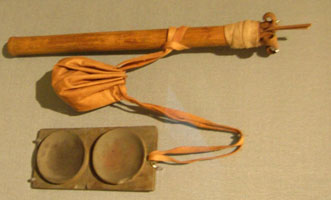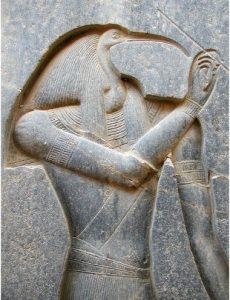It is no exaggeration to say that we owe most of our knowledge of ancient Egypt to the work of her scribes. The ancient Egyptians covered their temples and tombs with hieroglyphs, but they also employed scribes to record everything from the stocks held in the stores for workers to court proceedings. Scribes recorded magic spells, wills and other legal contracts, medical procedures, tax records, and genealogies.


Scribes were central to the functioning of the centralised administration, the army, and the priesthood. In truth, very little happened in ancient Egypt which did not involve a scribe in some manner.
It is perhaps no surprise then that one of the most respected titles in ancient Egypt was “sesh” – “scribe”. The terms is more properly translated as “to draw” or “to create” rather than simply “to write” or “to read”. The occupation of scribe is also one of the earliest jobs. There are depictions of scribes (identified by the traditional scribal crossed legged pose and their scribal equipment) dating back to as early as the Old Kingdom.
The hieroglyphic language of the ancient Egyptians was complex and beautiful and those who mastered it held a valued position in society. Scribes were the protectors and developers of ancient Egyptian culture and central to academic research and the smooth running of the state apparatus. The scribes not only copied existing texts preserving them for future generations, they also edited existing works and wrote new texts. They were considered to be members of the royal court and as such did not have to pay tax, undertake military service, or perform manual labour.

Many positions of influence within the administrative hierarchy of ancient Egypt required scribal training, Those who could not read or write could employ the services of a scribe. Many pieces of correspondence include the phrase “May you be well when you hear this” which strongly implies that in some cases a scribe would actually read the documents out to its recipient – which would certainly be necessary with such a small proportion of the population being able to read or write.
The majority of scribal students were boys from middle or upper class families, but there is also significant evidence that boys from lower class families and girls learned to write. The restrictions on scribal training appear to have lessened as time passed. However, many scribal positions were to some degree hereditary. When the son of a scribe had completed his training he would often inherit his father’s job.

A large number of ostraca and papyrus dated to the New Kingdom were discovered in a pit close to the worker’s village at Deir el-Medina and many more fragments were scattered around the village itself. The fragments suggest that while the teachers were of course literate, many of them did not hold the specific occupation of scribe. Instead, the teachers included a number of draughtsman, a chief workman, and a deputy. The fragments also confirm that the students included children from the lower ranks (such as the children of a stonecutter) and at least one woman.
The evidence from Deir el-Medina also suggests that a large number of the inhabitants could read. Jars with re-usable labels would have been pointless if the residents could not read and write, and there were a number of notes written to the wives of the villagers which again would have been of limited use if these women were unable to read. It is, however, likely that the worker’s village was not typical of ancient Egyptian villages of the time, but this evidence certainly challenges suggestions that as little as one percent of the population could write.
Becoming a Scribe
The Egyptian’s hieroglyphic language is very complex, comprising of over seven hundred unique signs which could be combined to give layers of meaning. As a result, scribal training could take up to a decade to complete. Most students started their studies in a temple school at the age of five, but their formal scribal education would begin when they were around nine years old. Students would study hieroglyphics, hieratic, demotic (from around 400BC), and mathematics (“dena”), as well as writing, as this was required for many high level jobs such as architect, tax collector, and treasurer.
Discipline in an ancient Egyptian school was strictly enforced with some tutors resorting to the stick. This harsh discipline is underlined by the fact that the route of the word “teach” (“seba”) also means “beat.”
Scribal equipment
The scribe was generally depicted carrying the tools of his trade: a wooden palette with brushes and reed pens and a roll of papyrus.

Papyrus was the ancient world’s version of paper and in fact is the root of the word “paper”. It was made by slicing the yellowish-white pith of the papyrus reed into long strips and laying them out in horizontal and vertical layers to form a mat.
A sticky vegetable gum was poured over the sheets to fill up spaces in the mat and it was then pounded flat with a mallet and placed under a heavy weight to dry. Once the juices of the plant had evaporated the papyrus mat would be pliable and strong. It was polished with a piece of wood or ivory and was then ready to use. Papyrus was expensive and time consuming to make so students would practice by copying texts on ostraca.

The pen of a scribe was made from a thin-stemmed reed, usually around nine inches long. The end of the reed was hammered soft to cause it to fray, and then trimmed to create a brush.
Ink was carried in a flat pallet with two depressions cut into it; one for red ink and the other for black ink. Black ink was made from soot mixed with gum, and red ink was created from this same mixture by adding the dust of red oxide. Scribes generally wrote in red or black ink, with red ink being employed for important or magical terms and by tutors when correcting the work of their students (a practice which exists to this day!) Red ink was also used to indicate titles, headings and to mark the beginning of a new section of text.
A beautiful example of ancient Egyptian writing equipment was recovered from the Tomb of Tutankhamun.
Gods associated with writing
Writing was a highly regarded skill and closely associated with the divine. Hieroglyphs were known as “medju netjer” (“words of the gods”) and so it is not surprising that a number of the gods were depicted as scribes or associated with writing.


Thoth was the patron of scribes and was generally credited with the development of hieroglyphs. He was often depicted as a scribe and was responsible for recording the result of the “weighing of the heart” in the halls of judgment. Seshat was the goddess of writing (and either the wife or daughter of Thoth). She recorded the life of each person on the leaves of the sacred persea tree and was the official biographer of the pharaoh.
Bibliography
- Allen, James P. (2010) Middle Egyptian
- Bard, Kathryn (2008) An introduction to the Archaeology of Ancient Egypt
- Kemp, Barry J (1991) Ancient Egypt: Anatomy of a Civilisation
- Malek, Jaromir (1999) Egyptian Art
- Robins, Gay (2008) The art of Ancient Egypt
- Wilkinson, Richard H. (1992) Reading Egyptian Art
Copyright J Hill 2018